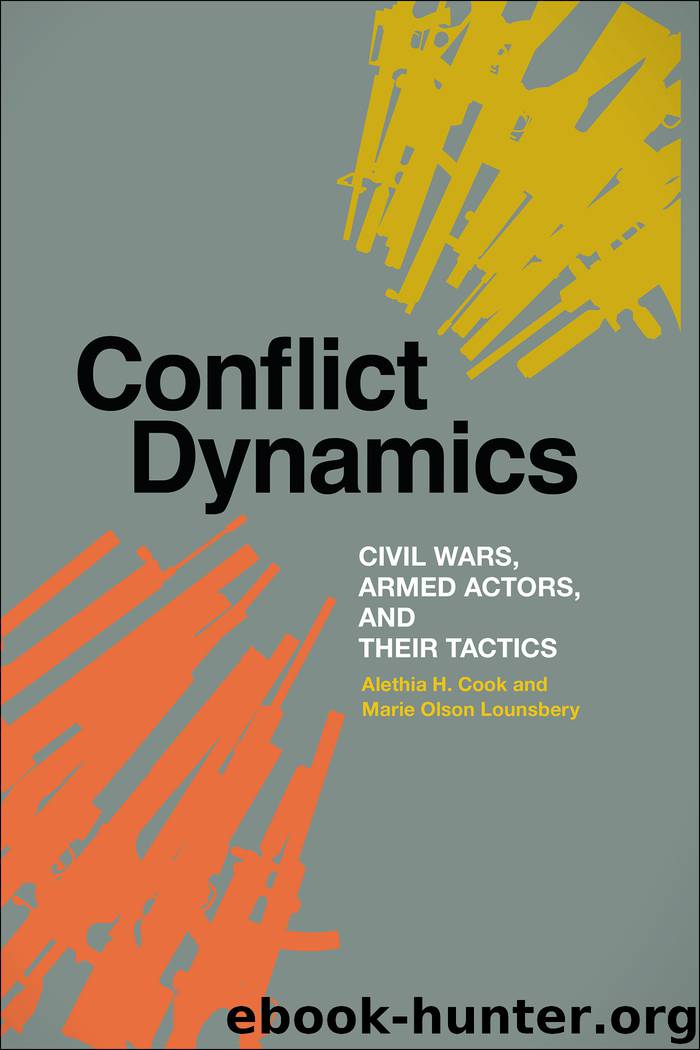Conflict Dynamics by unknow

Author:unknow
Language: eng
Format: epub
ISBN: 9780820338330
Publisher: University of Georgia Press
Published: 2017-01-15T07:00:00+00:00
CONCLUSIONS
Myanmar clearly involves a complex set of armed conflicts that have changed significantly over time. The theoretical framework put forth has proved to be an effective tool for understanding how and why they have changed in the way they have. Static factors, such as terrain, cultural aspects, and historical experiences, have created an environment conducive to guerrilla warfare that can persist, despite the increasingly repressive tactics employed by the government. It is also evident that the capacity of groups relative to that of the government has influenced conflict trajectory. When groups benefited from large numbers in comparison to those of the government, they were able to do well on the battlefield. When outside assistance was provided, it allowed groups to survive and sometimes flourish, even when a growing military was on the offensive, as did intergroup collaborations. When the tide of outside intervention shifted, however, insurgencies were diminished and intergroup fighting emerged.
Rebel groups’ capacities have been significantly influenced and improved through intergroup collaboration to an extent not seen in any of the other cases examined here. Although coalitions did form in the Republic of the Congo, the extensive sharing of resources, collaboration in battle, and the merging of groups into larger entities appears unprecedented. This allowed smaller groups to persist and larger groups to expand. In fact, despite the number of conflicts that existed and the divergent number of issues involved, intergroup collaboration was the norm, and intergroup conflict was fairly uncommon early in the Myanmar conflict histories. This changed, however, when the government actively pursued eliminating rivals through its Four Cuts policy. By breaking down intergroup collaboration, actively pursuing groups, promising economic opportunity to group leaders, and limiting external support to rivals, the government was effectively able to decrease the number of active armed conflicts that existed. Of course, the democratization movement emerged during this time, which served to perpetuate violence in Myanmar.
Download
This site does not store any files on its server. We only index and link to content provided by other sites. Please contact the content providers to delete copyright contents if any and email us, we'll remove relevant links or contents immediately.
Cecilia; Or, Memoirs of an Heiress — Volume 2 by Fanny Burney(31910)
Cecilia; Or, Memoirs of an Heiress — Volume 3 by Fanny Burney(31894)
Fanny Burney by Claire Harman(26561)
We're Going to Need More Wine by Gabrielle Union(19004)
Plagued by Fire by Paul Hendrickson(17372)
All the Missing Girls by Megan Miranda(15780)
Cat's cradle by Kurt Vonnegut(15261)
Bombshells: Glamour Girls of a Lifetime by Sullivan Steve(14024)
For the Love of Europe by Rick Steves(13602)
Leonardo da Vinci by Walter Isaacson(13236)
4 3 2 1: A Novel by Paul Auster(12331)
The remains of the day by Kazuo Ishiguro(8893)
Adultolescence by Gabbie Hanna(8889)
Note to Self by Connor Franta(7645)
Diary of a Player by Brad Paisley(7520)
Giovanni's Room by James Baldwin(7254)
What Does This Button Do? by Bruce Dickinson(6169)
Ego Is the Enemy by Ryan Holiday(5348)
Born a Crime by Trevor Noah(5336)
